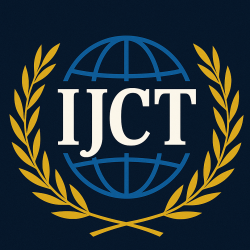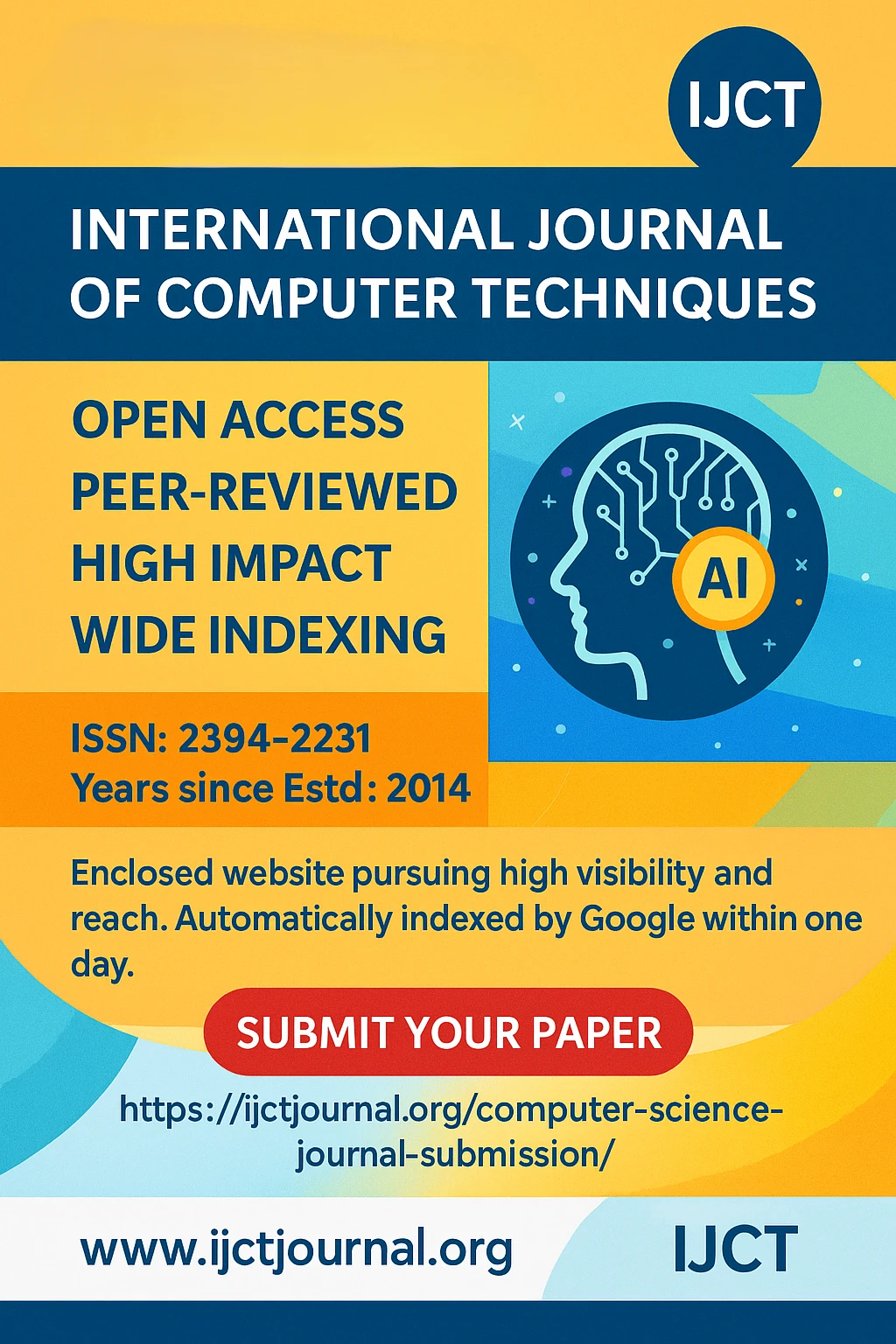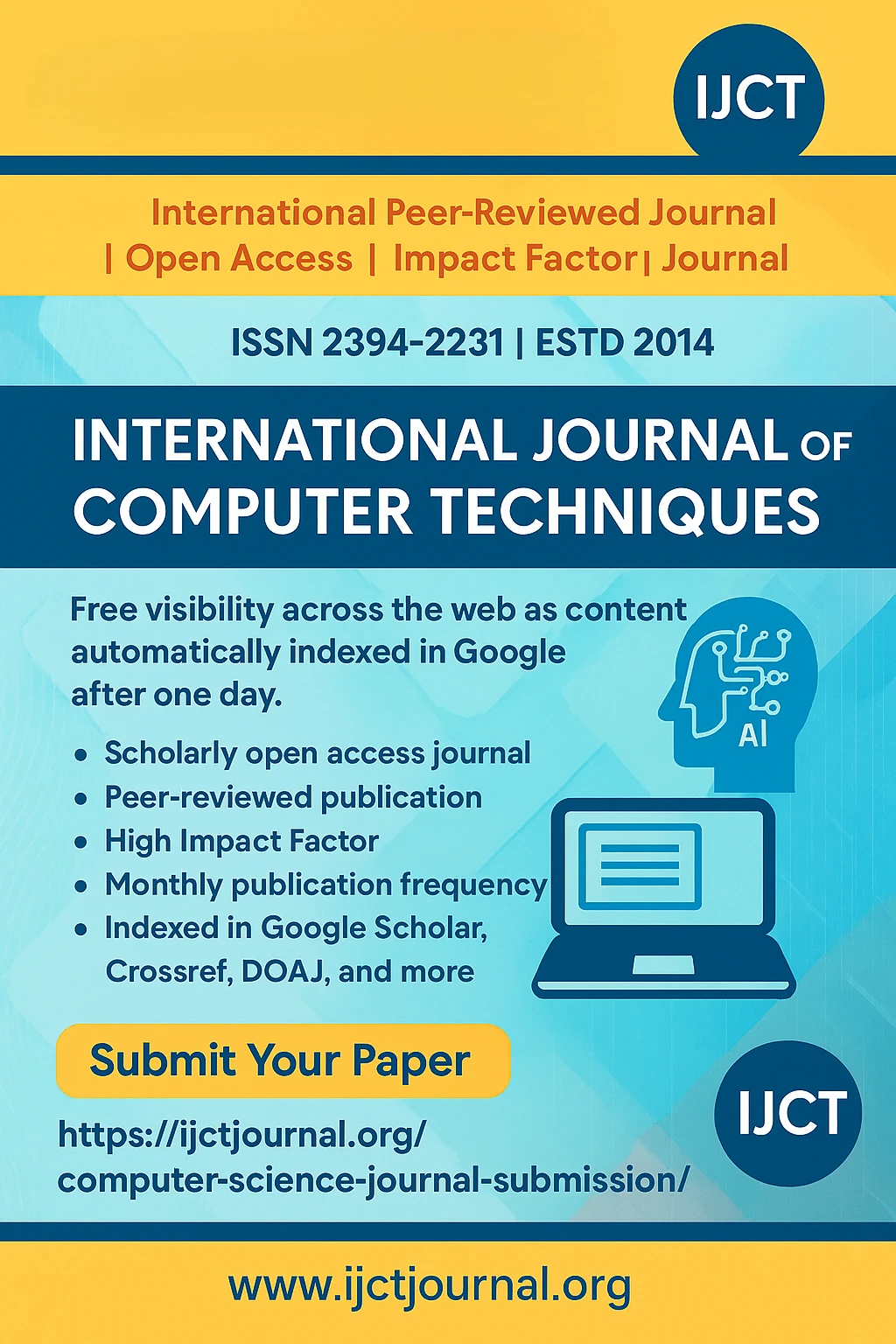
Autonomous Human Body Control, Part XV: Intradialytic Hypotension Control during Hemodialysis using First-order and D-P Compensators Compared with a PD Controller | IJCT Volume 12 – Issue 5 | IJCT-V12I5P67

International Journal of Computer Techniques
ISSN 2394-2231
Volume 12, Issue 5 | Published: September – October 2025
Author
Galal Ali Hassaan
Table of Contents
ToggleAbstract
This paper is the fifteenth in a series of research papers presenting the control of an autonomous human body. It handles the control of the intradialytic diastolic blood pressure in human hemodialysis operations using a first order and a D-P compensators from the second generation of control compensators. Some tuning techniques for the proposed controller/compensators are proposed based on zero/pole cancellation and fulfilling some time-based characteristics for the closed-loop control system. The step time response of the control system using the investigated controller/compensators is presented and compared with that of a conventional PD controller from the first generation of PID controllers tuned by the author. The comparison reveals the best controller/compensator among the three ones presented depending on a graphical and quantitative comparison study for reference input tracking
Keywords
Autonomous human body control, hypotension control, first order compensator, D-P compensator, PD controller, controller/compensators tuning.Conclusion
-This research paper investigated the use of first order and D-P compensators from the second generation of control compensators compared with a PD controller from the first generation of PID controllers to control the diastolic blood pressure a human body during hemodialysis.
-The process under control was identified as an unstable process having a first order + an integrator process transfer function without time delay.
-The performance of the proposed controller/compensators was assigned through the investigation of the step time response of the control system comprising the controller/compensator and the DBP process.
-The tuning technique used to optimize the controller/compensator parameters was based on the zero/pole cancellation technique and fulfilling specific requirements for the settling time and the steady state of the control system.
-The three proposed controller/compensators succeeded to eliminate completely the maximum percentage overshoot of the closed-loop control system for reference input tracking.
-The settling time of the step input tracking time response (for 2 % tolerance) was assigned to be only half an hour for the three controller/compensators indicating fast time response compared with infinity for the uncontrolled DBP process.
-With the proposed controller/compensators it is possible to select any value for the settling time where the controller/compensator parameters will change accordingly.
-The three proposed controller/compensators succeeded to provide a step time response having a delay time less than 0.144 h.
-The three proposed controller/compensators succeeded to provide a step time response having a rise time less than 0.288 h.
-Through the tuning approaches used it was possible for the proposed controller/ compensators provided step time response to step input tracking without steady-state error.
-The PD controller and the D-P compensator proved in this application to be the best controller/compensator because of their ideal step shape without any overshoot, undershoot or steady-state error.
However, the D-P compensator was selected as the best controller/compensator because of its simple design without summing point electronic circuit.
References
[1]V. Chauhan, “Low blood pressure from hemodialysis: Signs and prevention”, https://www.verywellhealth.com/complications-at-hemodialysis-low-blood-pressure-3954431 ,February 2025.
[2]S. Dheenan and W. Henrich, “Prevention dialysis hypotension: A comparison of usual protective maneuvers”, Kidney International, vol.59, pp.1175-1181, 2001.
[3]J. Kariazis et al., “Dialysate calcium profiling hemodialysis: Use and clinical implications”, Kidney International, vol.61, pp.276-287, 2002.
[4]M. Papadimitrion et al., “Hypertension and left ventricular mass index in patients on regular hemodialysis”, Hemodialysis International, vol.9, issue 1, p.86, 2005.
[5]L. Gabutti et al., “Hemodynamic consequences of changing bicarbonate and calcium concentrations in hemodialysis fluids”. Nephrol Dial Transport, vol.24, pp.973-981, 2009.
[6]N. Shahaholian, M. Ghafourifard and F. Shafiei, “The effect of sodium and ultrafiltration profile combination and cold dialysate on hypotension during hemodialysis and its symptoms”, IJNMR, vol.16, 3, pp.212-216, 2011.
[7] R. A. Soliman et al., “Assessment of hypotension during dialysis as a manifestation of myocardial ischemia in patients with chronic renal failure”, The Egyptian Journal of Critical Care Medicine, vol.2, pp.12-18, 2014.
[8]A. Khan et al., “Management of patient care in hemodialysis while focusing on cardiovascular disease events and the typical role of hyper and/or hypotension: A systematic review”, Biomedical Research International, vol.2016, issue 1, 10 pages, 2016.
[9]P. Aunon et al., “Chronic hypotension in dialysis is a prognostic factor in the evaluation of kidney transplantation”, Transplantation, vol.102, 2018.
[10]J. A. Pulido et al., “Predicting the appearance of hypotension during hemodialysis sessions using machine learning classifiers”, International Journal of Environmental Research and Public Health, vol.18, issue 2364, 17 pages, 2021.
[11]A. Davenport, “Why is intradialytic hypotension the commonest complication of outpatient dialysis treatment?”, Kidney International Reports, vol.8, pp.401-418, 2023.
[12]M. Arasneshad et al., “The effect of ascending-descending ultrafiltration and sodium profiles on blood pressure in hemodialysis patients: A randomized cross-over study”, BMC Nephrology, vol.25, issue 128, 9 pages, 2024.
[13]M. Fahmy, F. Abdel Moez and E. Mohammed, “Intradialytic hypotension in hemodialysis patients and its relation to duration of hemodialysis”, Journal of Current Medical Research and Practice, vol.10, issue 3, 8 pages, 2025.
[14]A. Shuaib and M. Ahmed, “Robust PID control system design using ITAE performance index (DC motor model)”, International Journal of Innovative Research in Science Engineering and Technology, vol.3, issue 8, pp.15060-15067, 2014.
[15]C. P. Lopez, “MATLAB optimization techniques”, Springer, 2014.
[16]Mathworks, “Step response of dynamic system”, https://www.mathworks.com/help/ident/ref/dynamicsystem.step.html , 2023.
[17]G. A. Hassaan, “Tuning of a PD controller used with second-order processes”, International Journal of Engineering and Technical Research, vol.2, issue 7, pp.120-122, 2014.
[18]N. R. Castro et al., “Modeling PD closed-loop control problems with fuzzy differential equations”, Automatika, vol.47, issue 4, pp.960-967, 2016.
[19]P. Aryan and G. Raja, “Equilibrium-optimized IMC-PD double-loop control strategy for industrial processes with dead time”, in G. Manik et al. (Editors), “Recent advances in mechanical engineering”, Springer, Singapore, 2023.
[20]M. C. Campi, “The problem of pole-zero cancellation in the transfer function identification and application to adaptive stabilization,” Automatica, vol.32, issue 6, pp. 849-856, 1996.
[21]Electrical for You, “Settling time: What is it?”, https://www.electrical4u.com/settling-time , 25 April, 2024.
[22]Heart, “Understanding blood pressure readings”, https://www.heart.org/en/health-topics/high-blood-pressure/understanding-blood-pressure-readings , 2025.
[23]G. A. Hassaan, “Tuning of a first-order lag-lead compensator used with a very slow second-order process”, International Journal of Advances in Engineering and Technology, vol.7, issue 4, pp.1786-1791, 2015.
[24]G. A. Hassaan, “Tuning of a feedforward lag-lead first-order compensator used with a delayed double integrating process”, International Journal of Recent Engineering Science, vol.11, issue 5, pp.3-7, 2015.
[25]G. A. Hassaan, “Novel characteristics evaluation of critically damped second-order-like dynamic systems”, International Journal of Computer Techniques, vol.12, issue 5, pp.167-174, 2025.
[26]M, Nasser, A. Tibi and E. Smith, “Ibn Sina’s canon of medicine: 11th century rules for assessing the effects of drugs”, Journal of the Royal Society of Medicine, vol.108, pp.78-80, 2009.
[27]R. Hajar, “The air of history (part V) Ibn Sina (Avicenna): The great physician and philosopher”, Heart View, vol.14, issue 4, pp.196-201, 2013.
Journal Covers
IJCT Important Links
© 2025 International Journal of Computer Techniques (IJCT).












